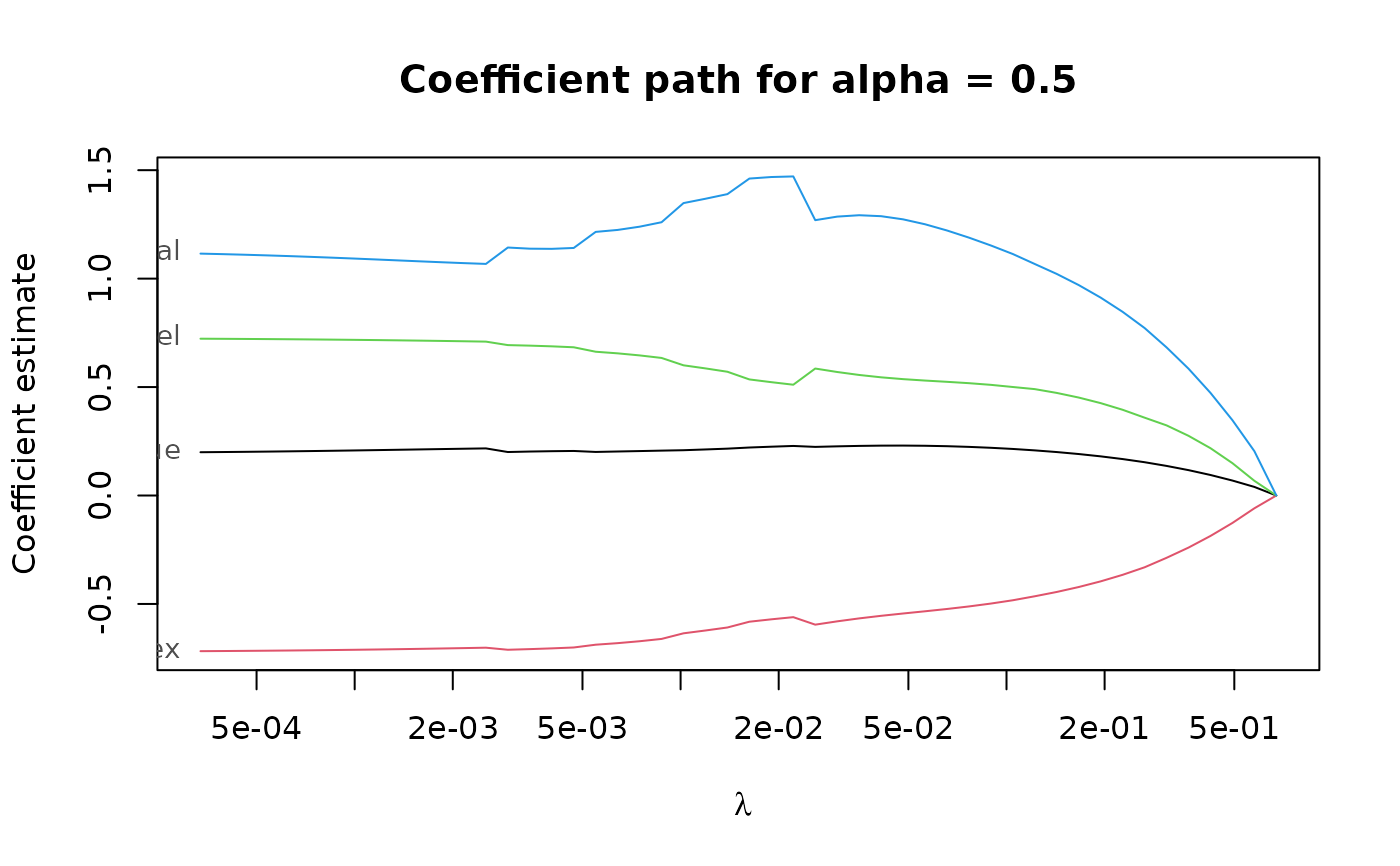Extract coefficients from an adaptive PENSE (or LS-EN) regularization path fitted by pense()
or elnet().
# S3 method for class 'pense_fit'
coef(
object,
lambda,
alpha = NULL,
sparse = NULL,
standardized = FALSE,
exact = deprecated(),
correction = deprecated(),
...
)Arguments
- object
PENSE regularization path to extract coefficients from.
- lambda
a single number for the penalty level.
- alpha
Either a single number or
NULL(default). If given, only fits with the givenalphavalue are considered. Ifobjectwas fit with multiplealphavalues, and no value is provided, the first value inobject$alphais used with a warning.- sparse
should coefficients be returned as sparse or dense vectors? Defaults to the sparsity setting in
object. Can also be set tosparse = 'matrix', in which case a sparse matrix is returned instead of a sparse vector.- standardized
return the standardized coefficients.
- exact, correction
defunct.
- ...
currently not used.
Value
either a numeric vector or a sparse vector of type
dsparseVector
of size \(p + 1\), depending on the sparse argument.
Note: prior to version 2.0.0 sparse coefficients were returned as sparse matrix
of type dgCMatrix.
To get a sparse matrix as in previous versions, use sparse = 'matrix'.
See also
coef.pense_cvfit() for extracting coefficients from a PENSE fit with
hyper-parameters chosen by cross-validation
Other functions for extracting components:
coef.pense_cvfit(),
predict.pense_cvfit(),
predict.pense_fit(),
residuals.pense_cvfit(),
residuals.pense_fit()
Examples
# Compute the PENSE regularization path for Freeny's revenue data
# (see ?freeny)
data(freeny)
x <- as.matrix(freeny[ , 2:5])
regpath <- pense(x, freeny$y, alpha = 0.5)
plot(regpath)
 # Extract the coefficients at a certain penalization level
coef(regpath, lambda = regpath$lambda[[1]][[40]])
#> (Intercept) lag.quarterly.revenue price.index
#> -7.9064997 0.2125014 -0.7070107
#> income.level market.potential
#> 0.7141099 1.0796662
# What penalization level leads to good prediction performance?
set.seed(123)
cv_results <- pense_cv(x, freeny$y, alpha = 0.5,
cv_repl = 2, cv_k = 4)
plot(cv_results, se_mult = 1)
# Extract the coefficients at a certain penalization level
coef(regpath, lambda = regpath$lambda[[1]][[40]])
#> (Intercept) lag.quarterly.revenue price.index
#> -7.9064997 0.2125014 -0.7070107
#> income.level market.potential
#> 0.7141099 1.0796662
# What penalization level leads to good prediction performance?
set.seed(123)
cv_results <- pense_cv(x, freeny$y, alpha = 0.5,
cv_repl = 2, cv_k = 4)
plot(cv_results, se_mult = 1)
 # Extract the coefficients at the penalization level with
# smallest prediction error ...
coef(cv_results)
#> (Intercept) lag.quarterly.revenue price.index
#> -7.9064997 0.2125014 -0.7070107
#> income.level market.potential
#> 0.7141099 1.0796662
# ... or at the penalization level with prediction error
# statistically indistinguishable from the minimum.
coef(cv_results, lambda = '1-se')
#> (Intercept) lag.quarterly.revenue price.index
#> -7.8652589 0.2141280 -0.7053433
#> income.level market.potential
#> 0.7126978 1.0754335
# Extract the coefficients at the penalization level with
# smallest prediction error ...
coef(cv_results)
#> (Intercept) lag.quarterly.revenue price.index
#> -7.9064997 0.2125014 -0.7070107
#> income.level market.potential
#> 0.7141099 1.0796662
# ... or at the penalization level with prediction error
# statistically indistinguishable from the minimum.
coef(cv_results, lambda = '1-se')
#> (Intercept) lag.quarterly.revenue price.index
#> -7.8652589 0.2141280 -0.7053433
#> income.level market.potential
#> 0.7126978 1.0754335